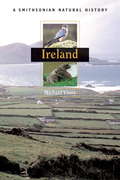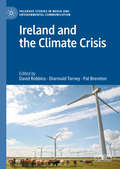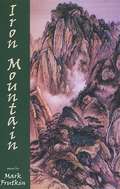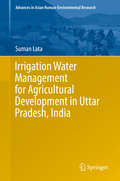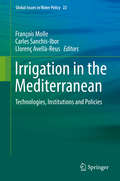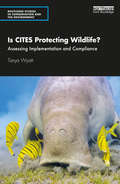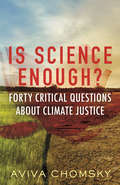- Table View
- List View
Ireland
by Michael VineyIreland conjures up images of nature's majesty: sweeping coastlines, rolling green hills, and secluded peat bogs and marshlands. A place of legendary beauty, it is also a land with a rich natural history. Michael Viney invites us to discover the geologic forces that created the island, peer into the famous bone caves that hold unique clues about animals from long ago, and experience the dramatic scenes of the cliff-lined coast and tempestuous seas.Viney begins deep in the past, when rivers of molten rock and enormous glaciers stripped the land bare. Soon after the glaciers retreated, the island was transformed into a fresh, new landscape, home to an intriguing variety of plants and animals, and an environment that has cultivated a rich human history and inspired countless myths. Infused with the lyricism of Irish prose, Ireland: A Smithsonian Natural History is indispensable for anyone seeking to understand the natural beauty of the Emerald Isle.
Ireland and the Climate Crisis (Palgrave Studies in Media and Environmental Communication)
by David Robbins Pat Brereton Diarmuid TorneyThis book provides a comprehensive overview of Ireland’s response to the climate crisis. The contributions, written by leading scholars across a range of disciplines in the social sciences, humanities and beyond, shed light on diverse aspects of the climate crisis, the factors shaping Ireland’s response, and prospects for the future. Long regarded as a ‘climate laggard’, Ireland’s response to the urgent societal challenge of climate change has seen new momentum in recent times. The volume will serve as a key reference point for academics, students, policymakers, and a wide range of stakeholders. It will be of interest to readers within Ireland, as well as further afield, who wish to gain a deeper understanding of the constraints on, and opportunities for, successful climate action in Ireland.
Iris Murdoch’s Wild Imagination: Nature and the Environment (Iris Murdoch Today)
by Lucy OultonThis book presents the first ecocritical study of novelist, philosopher, poet and public intellectual Iris Murdoch (1919–1999). It brings her love of the natural world into the light, arguing for its critical significance when Murdoch conveys an awareness of intricately interconnected ecologies through her work: an awareness that anticipates the motivations and concerns of modern-day environmental humanities. The book is the first of its kind to assess some of Murdoch's poems, seen as early articulation of the environmental imagination that finds recurrent expression in her novels, philosophical writings and personal journals throughout her writing life. This book offers a significant entry point for a new research direction in Murdoch studies by explicating her unique perspective on the natural world.
Irish Contemporary Landscapes in Literature and the Arts
by Marie MianowskiLooking at representations of the Irish landscape in contemporary literature and the arts, this volume discusses the economic, political and environmental issues associated with it, questioning the myths behind Ireland's landscape, from the first Greek descriptions to present day post Celtic-Tiger architecture.
Irish Linen
by Candace McCarthySHE DESIRES ONLY HIM. . .Meghan McBride owes her life to the elegant stranger who saved her from a brutal attacker. Death had cruelly taken away her father on this long voyage to America, leaving her alone and prey to the dangers that lay beyond her Irish homeland. Now, in need of a man's protection until they reach Delaware's shores, she agrees to pose as Lucas Ridgely's bride-to-be.. . .BUT SHE WAS PROMISED TO ANOTHERMeghan is nothing like the pampered beauties Lucas is used to courting, but this waif-like woman with the haunting air of melancholy stirs something deep inside him. In America, a man waits for her. But the thought of Meghan in another's arms drives Lucas almost to madness. Somehow, he must find a way to claim her for his own, to show her the true meaning of passion—and to convince her that promises are made to be broken. . .and true love is meant to be fulfilled.121,800 Words
Irish Red: Son of Big Red (Famous Dog Stories)
by Jim KjelgaardIrish Red: Son of Big Red A TALE OF A TRUE CHAMPION This is the unforgettable story of a boy and his dog and the wilderness trek that sealed their friendship. It is the heartwarming story of Mike, the rebel who found his master. And of Danny, who learned that a dog, like a man, needs time to grow into his own. Together they faced a killing snowstorm and a murderous puma. Together they won a special victory which would forever establish the place of the Irish Red in the wild Wintapi.
Iron Mountain
by Mark FrutkinOf one of Mark Frutkin’s previous books of verse, Poetry Canada Review said it provided "a supernatural fusion of the earthbound with the heavenly to forge the lightning of poetry." Divided into two sections, one inspired by ancient Chinese art, the other limning the ambiguities and incongruities of the contemporary human condition, Frutkin’s new volume of poetry, Iron Mountain, often presents human beings wandering in the wilderness between two abysses while still appreciating the smell of pines, the softness of the rain, the brilliance of the stars, the hum of the computer, and the jostle of the crowd on the bus. These are poems of translucent delicacy harbouring hard truths where "A Taoist priest gulps the elixir/of immortality and blows away/in the dust,/a young Chinese girl/bumps me in the crowd/prompting a shiver/like a startled phoenix/dressed in my skin." In Frutkin’s vision the entire world is a written landscape that speaks to us of time, of change, of immutability, of radiant emptiness.
Iron and Water: My Life Protecting Minnesota's Environment
by Grant J. MerrittA memoir of family, mining pioneers and unscrupulous magnates, and the fight for Minnesota&’s natural resources In 1855 the Merritt family arrived in Minnesota, where a descendant, Alfred, would one day become one of the &“Seven Iron Men&”—builders of the first mines to tap the state&’s great mineral wealth in the Mesabi Range. Another Merritt, more than half a century later, would lead the efforts to protect Lake Superior from damage caused by mining. Iron and Water is Grant J. Merritt&’s memoir of his life&’s work on behalf of Minnesota&’s people and environment and also the story of a significant family in state history.Merritt&’s family played a key role in the struggle over natural resources in Minnesota—for the enrichment of mining pioneers, the prosperity of the state and its people, and the prospect of a secure and healthy future. This complex tale begins with the adventure of discovering iron ore and building the mines, railroads, and docks to move it, then devolves into the intrigues of business partnerships gone bad and attempts by John D. Rockefeller to defraud the Merritts. What follows is an engrossing account of Grant Merritt&’s years in the halls of state politics and the trenches of environmental activism in defense of Minnesota&’s North Shore and Lake Superior&’s waters. The author&’s tenure as head of the Minnesota Pollution Control Agency under Governor Wendell Anderson and his service on the first board of the Minnesota Environmental Quality Council take us behind the scenes of landmark legal cases and crucial moments in Minnesota history—particularly the notable Reserve Mining case, in which the company was found liable for serious environmental and health threats on the shores of Lake Superior and ordered to be shut down. In these pages we encounter the people who were critical to this history, from robber baron Rockefeller to judges, activists, and politicians, including Walter Mondale and Jim Oberstar. In chronicling both the discovery of vast iron deposits on the Mesabi Range and the fight to save Lake Superior and Minnesota&’s natural riches, Iron and Water reveals how, whether alone or together, individuals wield the power to change the world.
Irons in the Fire
by John McpheeAnother of McPhee's anthologies of well-written, highly informed, and very enjoyable essays that originally appeared in the New Yorker magazine. Joihn McPhee has a talent for making any subject interesting, and the diversity of the subjects he shares with his readers just in this book is astounding - from branding cattle to mountains made of tires to forensic geology to Plymouth Rock, and more.
Irrigation Water Management for Agricultural Development in Uttar Pradesh, India (Advances in Asian Human-Environmental Research)
by Suman Lata<p>This book focuses on irrigation sources together with water management for agricultural development in Uttar Pradesh state of India. Being the most populous state of the country, it bears a burden of feeding about 199 million people of which major section relies on agriculture for their subsistence. This study makes comparison in the growth trends in the irrigated area, crop land use patterns and crop productivity at the district level in different periods of time. The book emphasizes on irrigation water management to optimize crop yields in order to increase Water Productivity of crops in low productivity regions of the state applying suitable technology. <p>This book appeals to researchers and students in geography and planning working on the topics of agriculture as well as irrigation and water management aspects.</p>
Irrigation in the Mediterranean: Technologies, Institutions and Policies (Global Issues in Water Policy #22)
by François Molle Carles Sanchis-Ibor Llorenç Avellà-ReusMediterranean irrigation is diverse due to, among other factors, the relative importance of water in the economy of each country, varied levels of aridity, heterogeneous levels economic, social and technological levels of development, and differences in political and social organization. However, most of the Mediterranean countries face similar problems to meet their water demands because of the scarcity and variability of renewable resources, growing water requirements from non-agricultural sectors, increasing environmental concerns related to water quality and environmental degradation, a social demand for larger public participation, and important technological changes. The time has come to reconsider the “not one drop lost to the sea” philosophy of yesteryears largely and to 'live within limits'.This book focuses on eight selected countries (Tunisia, Morocco, Spain, France, Italy, Turkey, Israel and Egypt) and provides a comparative perspective that both thoroughly explores their specificities and identifies the common challenges faced by the irrigation sector in these countries. The book has been written at a critical moment, when the continued application of a supply-side water management model is revealing its unsustainable nature in numerous places; when significant technological changes are taking place in the irrigation sector; when new forms of management and governance are widely held as badly needed; and finally, when climate change is compounding many of the difficulties that have characterized irrigation policies and practices in the past decades.This complicated future context makes Mediterranean irrigation face various political dilemmas on water management, raising social tensions, triggering territorial and land conflicts, and stimulating new technological developments. This book provides a timely analysis of the particular trajectory of eight Mediterranean countries in these uncertain transformations, and attempts to identify the best strategies to avert or overcome future risks.
Is CITES Protecting Wildlife?: Assessing Implementation and Compliance (Routledge Studies in Conservation and the Environment)
by Tanya WyattThis book assesses the Convention on International Trade in Endangered Species of Wild Fauna and Flora (CITES), examining both implementation and compliance. Humans are causing a biodiversity crisis, where 1 million species are facing extinction. Species are dying, in no small part, because they are overexploited, poached and trafficked and CITES is the main international instrument designed to protect traded wildlife. Does the state of the world’s species mean CITES is failing? This book explores the implementation of and compliance with CITES by all 183 member countries. It is imperative we know the nature and extent of the implementation of and compliance with CITES legislation in all parties to fully understand the impact of legal and illegal trade on species survival. Through extensive legislative content analysis, a Delphi iterative survey, and semi-structured interviews, this is the first book to share empirical research about CITES implementation and compliance. This book contains a comprehensive analysis of the state of CITES, what is done well, what could be done better, and what the future might bring to try to curtail the slide of the world’s wildlife into extinction. By identifying lessons learned in relation to CITES legislation, implementation and compliance this book provides hard evidence to member countries as to how their own practice can be improved. This timely book will be essential reading for students and academics interested in wildlife law, trade and trafficking, green criminology and biodiversity conservation more broadly. It will also be of interest to professionals working in wildlife law enforcement.
Is It Really Green?: Everyday Eco Dilemmas Answered
by Georgina Wilson-PowellFind clarity on everyday green-living dilemmas to maximize your sustainabilityAre paper bags always more environmentally friendly than plastic? How much better for the planet are electric cars? What saves more water - using the dishwasher or washing up by hand?We all want to do the right thing for the planet, but with so many factors at play, it can be difficult to work out which is the greenest way. With answers to more than 140 everyday green-living questions, Is It Really Green? cuts through the confusion and gives you the facts.Get to the heart of each eco-conundrum, interrogate your instincts, and make informed decisions to reduce your ecological footprint.
Is Our Food Safe? A Consumer's Guide to Protecting Your Health and the Environment
by Warren Leon Caroline Smith DewaalEvery day, new warnings emerge about the safety of the food in our markets, school cafeterias, and restaurants. As industry and government officials rush in with reassurances--and food alarmists call for drastic changes in the American diet--ordinary consumers are caught in the middle. Is Our Food Safe?separates the facts from the rumors and offers straightforward, reliable advice on how to protect your health and the environment without going to extremes. Is Our Food Safe?answers common questions about the safety of meat, dairy products, fish, fruits, and other foods that make up our daily diet. It assesses the positive and negative aspects of genetically engineered foods, compares organic and conventionally produced foods, and makes recommendations about when (and if) you should choose local suppliers over industry giants. It also explains which foods to eat and which to avoid if you are concerned about clean water and air and a safe environment. Finally, it provides valuable information on how you can improve the quality of the food available in your communities, including specific issues to raise with grocers and food service providers.
Is Science Enough?: Forty Critical Questions About Climate Justice (Myths Made in America)
by Aviva ChomskyWhy social, racial, and economic justice is just as crucial as science in determining how humans can reverse climate catastrophe.We are facing a climate catastrophe. A plethora of studies describe the damage we&’ve already done, the droughts, the wildfires, the super-storms, the melting glaciers, the heat waves, and the displaced people fleeing lands that are becoming uninhabitable. Many people understand that we are facing a climate emergency, but may be fuzzy on technical, policy, and social justice aspects. In Is Science Enough?, Aviva Chomsky breaks down the concepts, terminology, and debates for activists, students, and anyone concerned about climate change. She argues that science is not enough to change course: we need put social, racial, and economic justice front and center and overhaul the global growth economy.Chomsky&’s accessible primer focuses on 5 key issues:1) Technical questions: What exactly are &“clean,&” &“renewable,&” and &“zero-emission&” energy sources? How much do different sectors (power generation, transportation, agriculture, industry, etc.) contribute to climate change? Can forests serve as a carbon sink?2) Policy questions: What is the Green New Deal? How does a cap-and-trade system work? How does the United States subsidize the fossil fuel industry?3) What can I do as an individual?: Do we need to consume less? What kinds of individual actions can make the most difference? Should we all be vegetarians?4) Social, racial, and economic justice: What&’s the relationship of inequality to climate change? What do race and racism have to do with climate change? How are pandemics related to climate change?5) Broadening the lens: What is economic growth? How important is it, and how does it affect the environment? What is degrowth?
Is This a House for Hermit Crab?
by Megan McDonaldFollow a hermit crab on the perilous journey to replace his outgrown shell in this classic picture book by the author of the popular Judy Moody and Stink series.Hermit Crab has outgrown his shell, and it&’s time for a new home to keep him safe from predators. The beach is strewn with possible choices, but none are quite right. A rock is too heavy; a tin can is too noisy; a fishing net has too many holes. He stepped along the shore,by the sea, in the sand . . .scritch-scratch, scritch-scratchWhen a giant wave sends Hermit Crab careening toward a hungry porcupine fish, will he find a hiding place in time? Katherine Tillotson&’s immersive artwork breathes new life into this classic text by Megan McDonald, beloved author of the Judy Moody series. Brand-new backmatter provides further learning about all things hermit crab.A Junior Library Guild Gold Standard Selection
Is Wildness Over? (Where Am I?)
by Paul WapnerWildness was once integral to our ancestor’s lives as they struggled to survive in an unpredictable environment. Today, most of us live in relative stability insulated from the vicissitudes of nature. Wildness is over, right? Wrong, argues leading environmental scholar Paul Wapner. Wildness may have disappeared from our immediate lives, but it’s been catapulted up to the global level. The planet itself has gone into spasm - calving glaciers, wildfires, heatwaves, mass extinction, and rising oceans all represent the new face of wildness. Rejecting paths offered by geoengineering and de-extinction to bring the Earth under control, Wapner calls instead for ‘rewilding’. This involves relinquishing the desire for comfort at all costs and welcoming greater uncertainty into our own lives. To save ourselves from global ruin, it is time to stop sanitizing and exerting mastery over the world and begin living humbly in it.
Is a River Alive?
by Robert MacfarlaneA #1 Sunday Times (UK) Bestseller • A New York Times "New Nonfiction to Read This Spring" Recommendation • A Guardian "Nonfiction to Look Forward To in 2025" Pick • A Washington Post "Book to Watch For" in 2025 • A Financial Times "What to Read in 2025" Selection • A Goodreads Most Anticipated Book of 2025 <P> From the best-selling author of Underland and "the great nature writer…of this generation" (Wall Street Journal), a revelatory book that transforms how we imagine rivers—and life itself. <P> Hailed in the New York Times as “a naturalist who can unfurl a sentence with the breathless ease of a master angler,” Robert Macfarlane brings his glittering style to a profound work of travel writing, reportage, and natural history. Is a River Alive? is a joyful, mind-expanding exploration of an ancient, urgent idea: that rivers are living beings who should be recognized as such in imagination and law. <P> Macfarlane takes readers on three unforgettable journeys teeming with extraordinary people, stories, and places: to the miraculous cloud-forests and mountain streams of Ecuador, to the wounded creeks and lagoons of India, and to the spectacular wild rivers of Canada—imperiled respectively by mining, pollution, and dams. Braiding these journeys is the life story of the fragile chalk stream a mile from Macfarlane’s house, a stream who flows through his own years and days. <P> Powered by dazzling prose and lit throughout by other minds and voices, Is a River Alive? will open hearts, challenge perspectives, and remind us that our fate flows with that of rivers—and always has. <b>New York Times Bestseller</b>
Is a River Alive?
by Robert MacfarlaneFrom the celebrated writer, observer and naturalist Robert Macfarlane comes a brilliant, perspective-shifting new book, which answers a resounding "yes" to the question of its title.At the heart of Is a River Alive? is a single, transformative idea: that rivers are not mere matter for human use, but living beings, who should be recognized as such in both imagination and law. Macfarlane takes the reader on a mind-expanding global journey into the history, futures, people and places of the ancient, urgent concept.Around the world, rivers are dying from pollution, drought and damming. But a powerful movement is also underway to recognize the lives and the rights of rivers, and to re-animate our relationships with these vast, mysterious presences whose landscapes we share. The young "rights of nature" movement has lit up activists, artists, law-makers and politicians across six continents—and become the focus for revolutionary thinking about rivers in particular.The book flows like water, from the mountains to the sea, over three major journeys. The first is to northern Ecuador, where a miraculous cloud-forest and its rivers are threatened with destruction by Canadian gold-mining. The second is to the wounded rivers, creeks and lagoons of southern India, where a desperate battle to save the lives of these waterbodies is underway. The third is to northeastern Quebec, where a spectacular wild river—the Mutehekau or Magpie—is being defended from death by damming in a river-rights campaign led by an extraordinary Innu poet and leader called Rita Mestokosho.Is A River Alive? is at once a literary work of art, a rallying cry and a catalyst for change. It is a book that will open hearts, spark debates and challenge perspectives. A clarion call to re-centre rivers in our stories, law and politics, it invites us to radically re-imagine not only rivers but life itself. At the heart of this vital, beautiful book is the recognition that our fate flows with that of rivers—and always has.
Is it Passover Yet?
by Alessandra Psacharopulo Chris BarashIt's time to clean the house, set out our best dishes, and fill our homes with food and family to celebrate the joyous holiday of Passover! In this sweet story, join one family as they gather with loved ones to share the joy of togetherness and freedom that Passover brings. This is a fixed-format ebook, which preserves the design and layout of the original print book.
Island 731: A Thriller
by Jeremy RobinsonA research vessel’s crew is shipwrecked on a mysterious island with a deadly past in this terrifying thriller by a New York Times–bestselling author.Mark Hawkins, former park ranger and expert tracker, is on board a research vessel studying the Great Pacific Garbage Patch. But his work is interrupted when his ship is plagued by malfunctions and the crew is battered by a raging storm . . .The next morning, the beaten crew awakens to find themselves anchored in the protective cove of a tropical island—and no one knows how they got there. The ship has been sabotaged, two crewmen are dead, and a third is missing. Hawkins spots signs of the missing man on shore and leads a small team to bring him back. But they soon discover evidence of a brutal history left behind by the island’s former occupants: Unit 731, Japan’s ruthless World War II human experimentation program. As more of his colleagues start to disappear, Hawkins begins to realize the horrible truth: that Island 731 was never decommissioned and the person taking his crewmates may not be a person at all—not anymore . . .“Robinson puts his distinctive mark on Michael Crichton territory with this terrifying present-day riff on The Island of Dr. Moreau . . . One of the best Jurassic Park successors.” —Publishers Weekly (starred review)
Island Bound
by Betty LevinChris Fossett can't resist a dare to spend a week alone on rocky, isolated Fowlers Island off the coast of Maine. He expects to spend his time hunting for food--not ghosts. But there's no denying an eerie presence in the fog, and Chris recalls his grandfather's tales of a girl who was left behind on the island. A fierce girl...who may still be there. Joellen Roth, who comes to the island's bird cliffs with her scientist father and his new girlfriend, wants nothing to do with Chris--nor he with her. But when the two stumble upon a hidden journal, the pages reveal a story strikingly similar to one that Joellen is writing.
Island Creatures
by Margarita EngleFrom award-winning author Margarita Engle comes an inspiring and luminous love story told in verse about childhood friends, once lost and now reconnected, and their fight to protect endangered animals.Every day, Vida reads to the creatures at the wildlife rescue center and dreams of her childhood in Cuba, where she and her best friend Adán adventured through the island rescuing animals from harm. Unbeknownst to her, Adán has also moved to Florida and is feeling trapped in his new home, buffeted by the stormy fights between his abuelo and papi. When a chance encounter with a captive fox leads to their reunion, Vida and Adán are able to find refuge from the cruelty that surrounds them in their soaring, rekindled romance. Their love reaches new heights as they work together at the zoo that rescues rare species, but soon they realize that this peace is only temporary. Much like the wildlife they want to protect, Vida and Adán are caught in a cycle of distrust and heartlessness. As old family grudges and painful memories come to light, can they and their families learn to heal and forgive each other for a brighter, kinder future?
Island Home: A Landscape Memoir
by Tim WintonThe writer explores his beloved Australia in a memoir that is “a delight to read [and] a call to arms . . . It beseeches us to revere the land that sustains us” (Guardian).From boyhood, Tim Winton’s relationship with the world around him?rock pools, sea caves, scrub, and swamp?has been as vital as any other connection. Camping in hidden inlets, walking in high rocky desert, diving in reefs, bobbing in the sea between surfing sets, Winton has felt the place seep into him, and learned to see landscape as a living process. In Island Home, Winton brings this landscape?and its influence on the island nation’s identity and art?vividly to life through personal accounts and environmental history.Wise, rhapsodic, exalted?in language as unexpected and wild as the landscape it describes?Island Home is a brilliant, moving portrait of Australia from one of its finest writers, the prize-winning author of Breath, Eyrie, and The Shepherd’s Hut, among other acclaimed titles.
